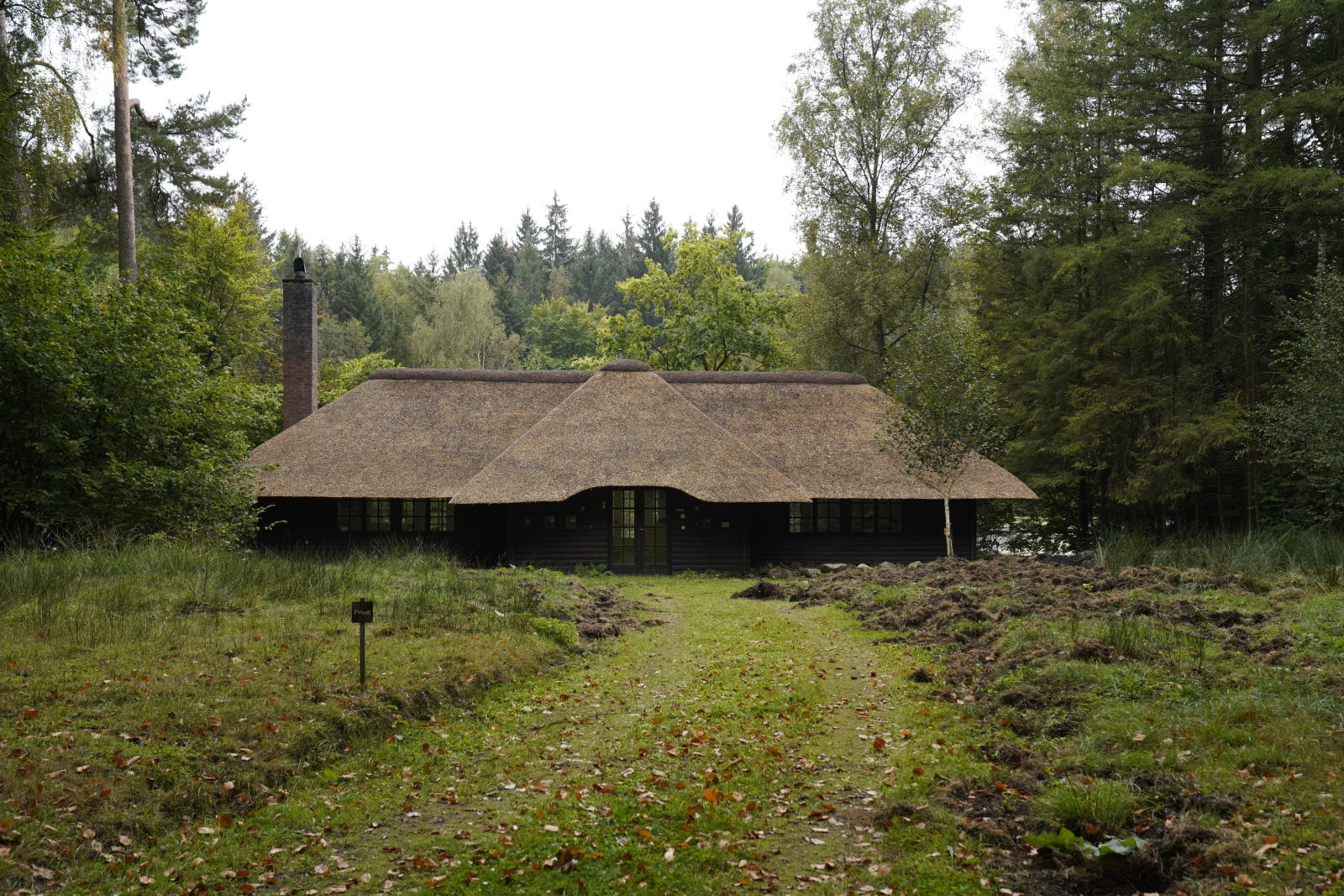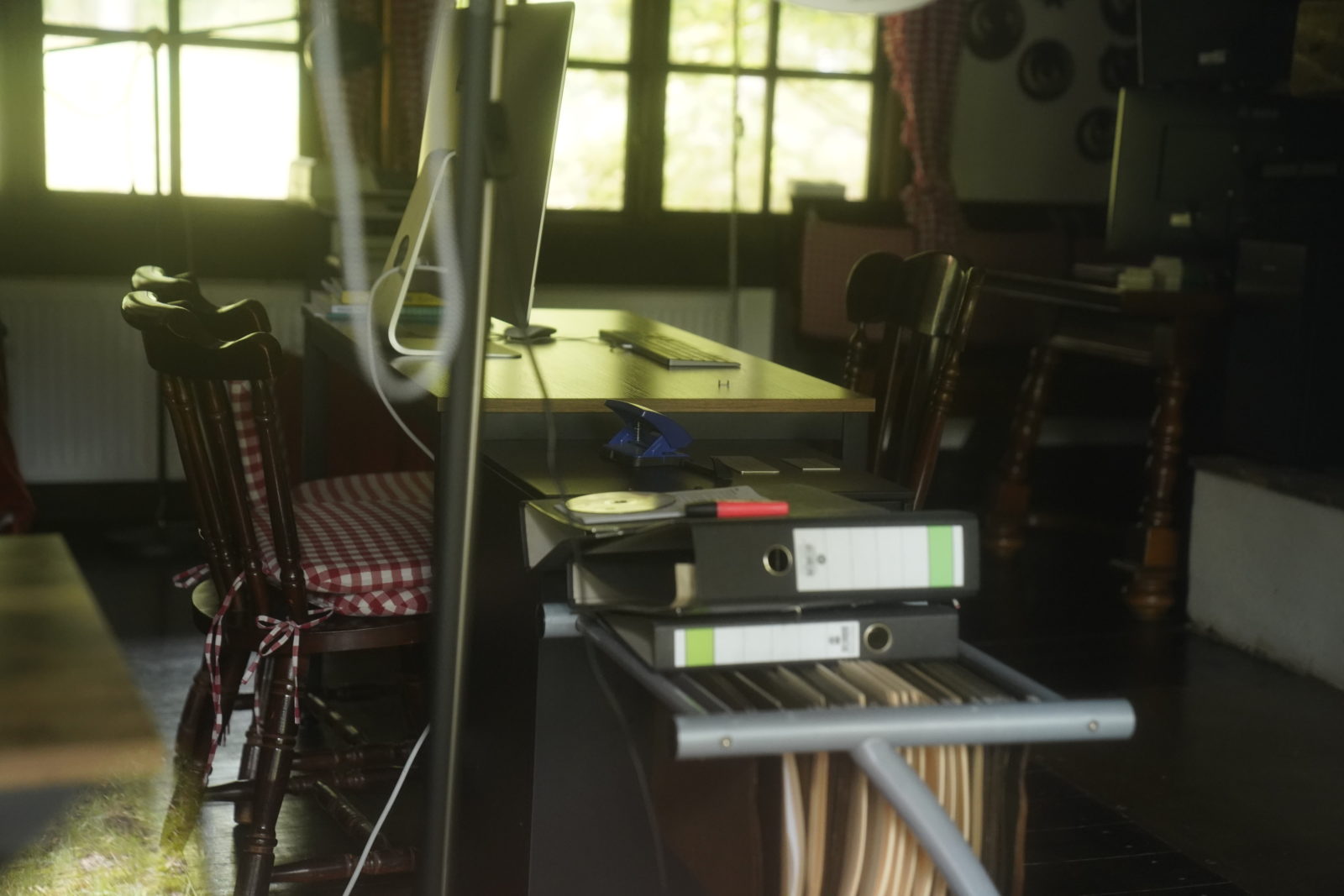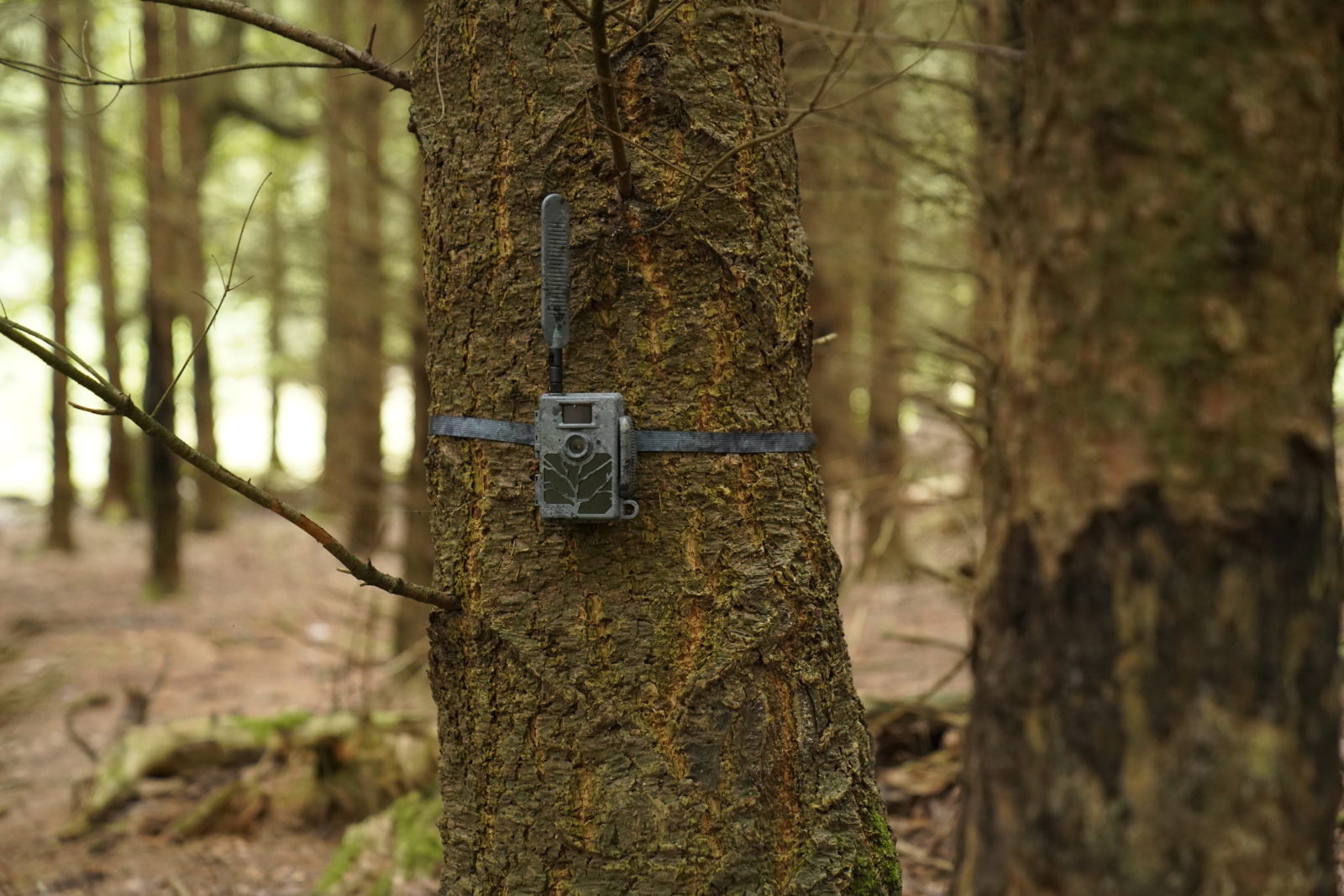Investigative
Reporting
Award
Bismarck’s Hut in the Forest – The most absurd tax haven in Germany
Stangenteich 2, 21521 Sachsenwald—at least 21 companies currently have their registered office at this unassuming address. But there is no factory, no large commercial building, not even a car park. About an hour’s walk from the nearest town, at the end of a muddy forest path and a few metres beyond a “No Entry” sign, stands only a lonely thatched roof surrounded by tall trees.
The old hunting lodge by the pond looks idyllic. Only at second glance do some of the details seem a little out of place: several letterboxes attached to the hut’s outer wall, company names on the doorbells and a small metal sign next to the door: “Office.” For about a decade, Count Gregor von Bismarck, great-great-grandson of the founder of the German Empire, Otto von Bismarck, has been operating a tax haven in this lonely hunting lodge, benefiting companies worth millions—and, most of all, Bismarck himself.

@ ZDF Magazin Royale
Together with ZDF Magazin Royale, we spent the last few months digging through the commercial register, sifting through tax equalisation tables and pouring over historical laws. We sent countless emails to ministries, agencies, and a district administrator. We made multiple trips to the mixed forests of Schleswig-Holstein and even resorted to methods that had a touch of a spy thriller. In the end, we sued Count Gregor von Bismarck based on press law. The result is a detailed picture of the most absurd tax haven in German history: Bismarck’s hut in the forest.
The forest of millionaires
To understand Bismarck’s tax haven hidden among the beeches and oaks, one must first understand the forest in which this hut stands. The Sachsenwald is the largest forested area in Schleswig-Holstein, a few kilometres east of Hamburg. It was once the hunting ground of Kaiser Wilhelm I. In 1871, he gave it to his Chancellor of the Reich, Otto von Bismarck, as a thank-you for unifying Germany into the German Empire. Even today, a large part of the Sachsenwald still belongs to the Bismarck family, who live at Friedrichsruh Castle on the edge of the forest.
The Sachsenwald is also the source of the enormous wealth of the Bismarck family. Within a few years, Otto von Bismarck transformed the forest given to him by the Kaiser into a flourishing timber trade that made him one of the richest Germans of his time. Today, the Bismarck family fortune is estimated at several hundred million euros.
The Bismarck family business in the forest
The former steam sawmill at Friedrichsruh, with which his great-great-grandfather laid the foundation for his wealth, is still operated by Gregor von Bismarck today. However, he has significantly transformed the operation over time. The former core of the Bismarck family business is now called “Sachsenwald Energy GmbH” and has greatly expanded its scope. In addition to the classic core business of a timber company—processing and distributing wood, as well as producing wood chips for power plants—the company now also engages in “trading raw materials, foreign currencies, securities, options, and index futures.” In addition, the former sawmill, which is now also active on the financial market, has moved its official business address: from “Am Sägewerk 4” (“at the sawmill 4”) to the new address “Am Stangenteich 2”—the hut in the forest.
This is not the only business Gregor von Bismarck runs. He is also the managing director of several real estate firms, a wealth advisory and trust company, and Floh Enterprises—a business that sells a combination of a backpack and a kick scooter, allegedly an invention of Gregor von Bismarck himself. Over the past ten years, all these companies have relocated to the hut in the Sachsenwald. In addition, a double-digit number of subsidiaries of international corporations have since joined them. All these companies in Bismarck’s hut benefit from a surprising advantage in the middle of the forest: very low trade taxes. Since 1958, the Sachsenwald has had a trade tax rate of only 275%—meaning companies here pay only about half as much as they would in nearby Hamburg.
What is trade tax?
Trade tax is the tax that companies pay on their profits. It is the most important source of income for municipalities. The money goes towards road construction, school renovations or city cleaning, for example. The municipalities have to forward part of the trade tax they collect to the federal and state governments as a levy. How much trade tax companies have to pay is determined by the trade tax rate. Each municipality is free to choose its own rate, with the only restriction being that it must be at least 200%. The average rate in Germany is 407%. Some municipalities deliberately set their trade tax rate very low to attract more companies to settle and pay taxes in their area. For companies, choosing such a tax haven as their location results in significant tax savings. A company with a trade income of one million euros would have to pay around 160,000 euros in trade tax at a collection rate of 470%, as is the case in Hamburg, for example. At a collection rate of 275%, however, it would only have to pay a little over 90,000 euros, a tax saving of almost 45%.
Municipality-free area: “a historical relic”
A forest with its own trade tax rate? This is possible due to a situation rooted in time when Germany was still ruled by an emperor. The Sachsenwald area gifted to the Bismarcks is not only their private forest, but has also been their private administrative unit for over a century. This is because Sachsenwald is a “municipality-free area.” it still operates under special rules dating back to pre-democratic times—specifically, the “Rural Municipality Code for the Province of Schleswig-Holstein” from 1892. This ordinance recognised independent estate districts as an equal form of municipal administration. Instead of an elected local council, the estate owner was designated as the “responsible for public duties” and managed the area.
In 1927, a Schleswig-Holstein law largely abolished these special privileges for estate districts and their owners. However, the law—still in effect today—contained one crucial exception: the Sachsenwald of the Bismarcks.
There are still some municipality-free areas in Germany. As a rule, these are uninhabited forests, lakes, coastal strips or state-owned military training areas. In the Sachsenwald, on the other hand, it is an aristocrat who has all the rights and duties that would otherwise belong to a democratically governed municipality. And one of the rights and duties of a municipality is to collect trade tax.
“He pays taxes to himself”
As the landowner of the municipality-free area of Sachsenwald, Gregor von Bismarck is entitled to propose a head of the estate, who is then appointed by the district administrator. In accordance with the 1927 law, this estate manager takes over the “governmental duties,” i.e. the day-to-day business of the estate district. They have a say in how high the trade tax rate should be, which is used to calculate how much trade tax companies in the area have to pay. And they are responsible for actually collecting the trade tax.
In recent decades, the Bismarcks have repeatedly appointed their employees as estate managers. Since 2021, this position has been held by Andreas I., who has worked in the Bismarcks’ administration for well over a decade. He is also the managing director of a real estate company—alongside Gregor von Bismarck—with its registered office in the hut in the forest. This employee and business partner of Gregor von Bismarck is currently responsible for collecting the trade tax that his own company and Bismarck’s companies in the forest have to pay—to the Sachsenwald, owned by estate holder Gregor von Bismarck.
In 1990, Schleswig-Holstein’s then-Interior Minister Hans-Peter Bull, described the tax practice in the Sachsenwald as “a kind of internal accounting.” “Since there is no municipality that can be the tax creditor, there can be no real taxpayer either,” he said in a state parliament debate. “So they pay their taxes to themselves, or what?” joked an SPD member of parliament at the time. But what caused hilarity among the MPs in 1990 has led to numerous companies paying their taxes not to a city or municipality, but to a nobleman who owes his special right to a legal relic from the imperial era.
At the time, Minister of the Interior Hans-Peter Bull announced in parliament that this “historical relic” of the municipality-free area would be abolished in the following year. However, the plan to incorporate the Sachsenwald into the surrounding municipalities failed. The municipalities were concerned that they would incur additional costs for maintaining the forest roads. At the same time, no tax revenue was expected from the forest to cover these costs.
A new address for companies worth millions
The former concerns about the lack of tax revenue in the Sachsenwald now appear to be outdated. In addition to Gregor von Bismarck’s companies, numerous other companies are currently registered in the small hut in the forest: more than a dozen subsidiaries of Luxcara, Aves One and the Heinze Group. They all pay their trade tax to the Sachsenwald and its landowner Gregor von Bismarck. Most of these companies have long names such as Aves Rail Rent Hamburg GmbH & Co. KG, Aves Rail III Holding GmbH & Co. KG & Co. KG or Luxcara Infrastructure GmbH.
The parent companies of most of these firms are two financially strong international companies headquartered in Hamburg. Luxcara, an asset manager for renewable energy, claims to manage a portfolio with an investment volume of six billion euros. Aves One, a company specializing in freight car leasing, had a total balance sheet of over one billion euros at the end of 2020. Until a few years ago, Aves One was listed in the Prime Standard of the Frankfurt Stock Exchange, a precursor to the DAX. In 2022, the company was acquired by its main shareholder and subsequently delisted. The company justified this move by pointing out the elimination of transparency obligations.
The Sachsenwald: a sustainable tax haven
We asked the parent companies and managing directors of the 21 companies why they share a tiny office in a wooden hut deep in the forest, miles away from civilisation. Their unanimous and surprising answer? Sustainability.
The main reason for settling in the forest was that most of the trade tax revenue is earmarked for the conservation of the Sachsenwald forest, emphasises Aves One, a freight car leasing company. “It’s just a good fit for our business.” The billion-euro investor Luxcara similarly explains that directing their business taxes toward the forest fits with their overarching corporate goal of advancing the energy transition. Meanwhile, the managing director of the now-insolvent Heinze Group wrote that he couldn’t work from home for personal reasons and was therefore grateful to find peace and quiet in his Sachsenwald office. What remains unclear, however, is just how quiet an office can be when 21 companies are operating out of a single room.
Count Gregor von Bismarck also cites noble environmental goals as the reason why his companies have been paying their taxes in his personal forest municipality for years: “The companies managed by me and Mr I. are committed to sustainable corporate governance. That is why they chose the Sachsenwald forest district as their place of business, because the trade taxes levied there are used for the maintenance and reforestation of the largest forest in northern Germany, which makes a valuable contribution (in addressing—ed) climate change.”
Moving his office to the forest hut doesn’t save Gregor von Bismarck any taxes, he writes to us. Furthermore, it is not true that he personally receives the trade tax collected: “The trade tax goes to the municipality-free area of Sachsenwald, where it is used entirely for the maintenance of paths and bridges, reforestation, salaries and other costs.” What the count fails to mention, however, is that he owns the Sachsenwald, the forestry workers are employed by him, and that the timber trade in the Sachsenwald, which is intertwined with the reforestation he mentioned, has been part of his family’s business for generations.
An office like an abandoned theatre set
All the companies registered in the hut in the forest agree on one thing: they are not operating letterbox companies designed to exploit the low trade taxes in the Sachsenwald by falsely claiming a local business presence. Employees, they insist, are regularly on-site, using the office space for legitimate business purposes. At the same time, both Aves One and Luxcara acknowledge that none of their subsidiaries employ any staff—they are purely administrative companies. Gregor von Bismarck, who rents out office space in his forest hut to these companies, emphasises that “proper offices” have been set up at Am Stangenteich 2, and that all the resident businesses regularly use them as their place of business.
At first glance through the large windows and glass doors of the hut, the out-of-place computer monitors among the rustic solid wood furniture immediately stand out. But a second look reveals a scene that resembles an abandoned theatre set rather than an office where millions in revenue are supposedly generated. Empty desks; empty wastepaper baskets underneath them; empty folders in an empty filing cabinet. In the small office kitchen, there is a box of peppermint tea that has been out of date for four years. The kitchen clock is 19 minutes slow. An unplugged refrigerator is kept ajar by a bottle of Bismarck water. It is an absurd-looking office set in the middle of the forest. What we didn’t see there on a normal Tuesday afternoon in September 2024 were people working in the hut. And it didn’t seem like it was just that day.
To find out how often people visit the forest hut, where 21 companies are based, we teamed up with ZDF Magazin Royale and installed a wildlife camera at the only public access road leading to the hut. Over two months, the camera was triggered every time someone passed by.

@ ZDF Magazin Royale
“Regularly used as a place of business”
The result? During the entire period—44 workdays plus weekends—people moved toward the hut only 25 times, despite it being the registered headquarters of 21 companies at Stangenteich. Sometimes, they were cyclists. Other times, it was a car. Occasionally, pedestrians. We don’t know whether these people were jogging, going for a walk or on their way to work. But in the majority of the cases we documented, it was very unlikely that the people were going to the hut to work in the traditional sense. They were obviously tourists, going on a weekend bike ride or driving a short distance before heading back in the opposite direction. What we did see regularly near the forest hut were squirrels, woodpeckers and plenty of wild boars.
We asked Gregor von Bismarck and the local companies how they explain the very low number of people around the hut and how this can be reconciled with their statements that the workplaces there are regularly used. None of them commented on this specifically. Luxcara merely wrote to us that the management of the companies went to work in the hut “usually at least once a month”. In previous responses, Gregor von Bismarck and Luxcara mentioned having documented when and how the hut in the forest was used as a place of business. We asked both of them to send us this data for the two-month period we monitored so that we could correct our findings if necessary. We never received a concrete answer.

@ ZDF Magazin Royale
Letterbox companies that don’t use their letterboxes?
What we never saw once over the entire two months on the access road to the hut was a postal vehicle. That’s why we sent letters, equipped with trackers, to the subsidiaries of the Hamburg-based companies Aves One and Luxcara. They were addressed to their company addresses in the Sachsenwald, using the exact company names listed on the letterboxes next to the door.
But instead of being delivered to the hut, the post delivered them to another of Gregor von Bismarck’s company headquarters: the former sawmill on the edge of the forest. From there, the letters were sent on their way again a day later, ending up in Hamburg—at the addresses of the parent companies: at Aves One directly on the Elbe and at Luxcara in the city centre, not far from the Alster. The letters never reached the cabin in the forest—i.e. the address on the envelope—on their circuitous route to Hamburg.
After one of our letters spent the weekend at Aves One’s headquarters in Hamburg following its delivery on a Friday morning, we tracked its movement again on Monday morning. This time, however, there were no detours through postal distribution centres—it travelled directly and swiftly by car to the hut in the Sachsenwald at Stangenteich 2. By this point, we had already confronted Aves One with the findings of our investigation. Shortly before our tracker left Aves One’s headquarters for the Sachsenwald, the company wrote to us, stating that the office in the hut was regularly in use. When we visited the hut again two days later, our letter—its tracker hidden inside a promotional brochure—was still there, seemingly placed in plain sight next to one of the tables.
Why mail addressed to tenants of his hut in the forest is first delivered to another of his business addresses and only then forwarded remains unanswered by Gregor von Bismarck, despite repeated inquiries. In an initial response, he stated that his business relationship with the companies in his forest hut was limited to renting office space and that he did not provide office services for them.
“It occasionally happens that we have the few letters still sent to us by post forwarded as a courtesy,” Aves One told us—while once again insisting that the office in the forest was regularly used. Luxcara, for its part, stated that the “processing” of mail for the companies in the forest hut was carried out “regularly at the business address there.” However, they claimed they could no longer trace the specific delivery route we described. Two business days earlier, our letter had reached the Luxcara headquarters. There, the tracker’s signal ended.
Subsidiaries and letterbox companies
This is a typical problem, says Christoph Trautvetter, coordinator of the Tax Justice Network. “Companies often don’t pay taxes where their profits are actually generated but shift them via subsidiaries to locations with lower tax rates.” According to him, the high number of businesses in the hut in the middle of the forest raises the question of whether the line has been crossed into illegality. “That’s why the authorities must look very carefully into this,” demands Trautvetter. Profit shifting becomes illegal when businesses create the illusion of actual operations at a given location while no real business activity takes place there. And in the case of Bismarck’s tax haven in the Sachsenwald, there are enough indications to warrant a thorough investigation.
When asked, the Hamburg tax authorities declined to comment on whether they are aware that multimillion-dollar Hamburg-based companies have registered their subsidiaries in a hut in the forest. They also refused to say whether investigations are underway, citing tax confidentiality. However, they did emphasize that they are aware of “the issue of abusive corporate tax arrangements in municipalities with conspicuously low tax rates.” This includes “merely maintaining a letterbox.”
Christoph Trautvetter from the Tax Justice Network also points out another key point that highlights the absurdity of Bismarck’s tax haven in the forest: the fact that in 2024 Germany, an aristocratic landowner can collect his own taxes through his estate manager. “We actually moved past that system,” Trautvetter points out. “The idea was to decide these matters democratically: we pay into the municipal treasury, and then the community determines how taxes are used—not a feudal lord.”
How much money goes to the Sachsenwald?
One crucial question remains unanswered: How much business tax has the Sachsenwald and its landowner Gregor von Bismarck collected from all the companies in the hut over the past decade?
In theory, it should be easy enough to find out. The Statistical Office of Northern Germany publishes detailed information on its website about how much trade tax each municipality in Schleswig-Holstein has collected each year. The municipalities are legally obliged to report this data to the statistical office—including the municipality-free area of Sachsenwald. However, when searching for numbers on the website of the Statistical Office, no data for the Sachsenwald can be found. When asked, the office admitted that, after internal research, they had discovered that no reports had been received from the Sachsenwald.
Every year, the Ministry of the Interior of Schleswig-Holstein publishes extensive calculations on the municipal financial equalisation, a redistribution of tax revenues between the state, districts and municipalities. In these long tables, the authority lists the actual trade tax revenue of each individual municipality in the federal state. The Sachsenwald Forest District is included in one of the lists. However, in the most recent calculation published by the Ministry, the actual trade tax revenue of the Sachsenwald is listed as zero euros, which is surprising given the business activity in the forest hut.
Even in earlier calculations from the last two decades, which we obtained through the German Freedom of Information Act (“Informationsfreiheitsgesetz”), the same figure is always given for the Sachsenwald: a trade tax revenue of zero euros. In response to our enquiry, the Ministry admitted that the figures from the Sachsenwald estate were missing there too—and that it was now being examined to what extent this data gap could affect the entire municipal financial equalisation system. After repeated enquiries, employees of the Schleswig-Holstein Ministry of Finance discovered that the Sachsenwald estate had duly paid the trade tax allocation to the state. The Ministry concluded from this that trade tax had clearly been levied in the Sachsenwald; however, no one there could answer the question of how much tax Bismarck’s estate manager had collected. And neither the district office of the Herzogtum Lauenburg district nor the office of Hohe Elbgeest, the smallest administrative unit above the municipalities, have any information on how much trade tax is due in the Sachsenwald.
The people who should know exactly how much money flows into Bismarck’s and his Sachsenwald coffers each year through the numerous company registrations in the hut are Gregor von Bismarck and his estate manager Andreas I. But we have not received the requested information from either the estate owner or his estate manager in response to our questions.
That is why we have now sued Gregor von Bismarck on the basis of press law. We want clear answers to our questions. After all, the rights and obligations of a municipality include not only collecting business tax, but also providing information to the press—even for an aristocratic landowner and his estate manager. Especially in 2024.
In the course of this investigation, we have been in contact with numerous authorities. We also repeatedly requested statements from Gregor von Bismarck, as well as the parent companies or managing directors of all firms registered at the hut in the forest, regarding our findings. To ensure transparency, we are publishing the full email correspondence, including the companies’ responses, here. Our inquiries were always based on the information available at the time, which may not always align with later findings. In some cases, authorities contradicted each other, and some offices provided different answers after repeated questioning.
The statements from Gregor von Bismarck and the companies also contain claims that we cannot verify. Additionally, at least one false statement appears in Bismarck’s response: he claimed that the Sachsenwald’s trade tax rate was in line with surrounding municipalities. However, as of now, the rate in the Sachsenwald forestry district is more than 100 percentage points lower than in any other municipality within the same administrative area.







